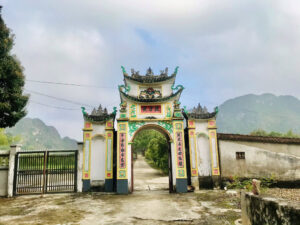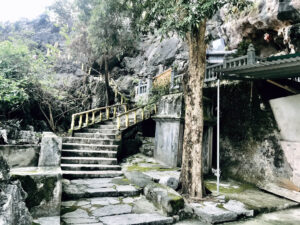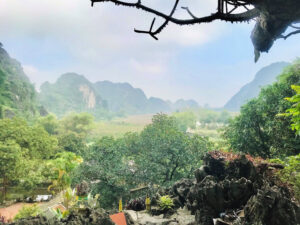Bàn Long Pagoda is considered one of the oldest sites within the Hoa Lu Ancient City complex, well-known even before the time of Dynasties and written histories. Amid an area where every other building dates back a millennium, it is an impressive achievement. However, the big attraction to this pagoda for many locals is the unusual stalactites/stalagmites rock formations concealed within the adjacent cave.
Situated on Đại Tượng Mountain, locals describe the mountain’s shape as that of a war elephant, turned and facing the Hoa Lu ancient capital. Unlike the most other temples in the area, Bàn Long Pagoda does not have the typical triple arch entrance known as “Tam Quan” but instead features the single gate of pre-dynastic Vietnam. .
Nevertheless, the pagoda building itself adheres to typical North Vietnamese temple style, replete with an ancient Logan tree situated next to a large turtle pond. There is also an Ancestor House, where former abbots at the pagoda are venerated, and a monk’s house where the present-day monks reside. The path from the entrance to the cave is along a straight path edged with rose pots, a stone walls and verdant forest- again a nod to the design of traditional Confucian architecture.
Bàn Long Pagoda
In Vietnamese “Long” means dragon and “Bàn” means bed or pedestal. Legend has it that some early foresters found the cave, perhaps as a refuge or a place to shelter for the night and discovered a stalagmite resembling a coiled dragon at rest.
The legend of dragons is a common one across many cultures (St George in the UK, tales of “Naga” in Indonesia, even ancient Greeks spoke flying serpents). So naturally petrified example discovered in a deep darkened cave hidden in mist-covered mountains would give rise to more than a few legends. Remember, this was centuries before there was the degrees in geology, biology or Religious Studies.
Wnen Lord Trinh Sam ( 1739-1782) visited here, he had three words inscribed on the gateway. ” Bàn Long Tự”. Which roughly translates as “dragon stone pedestal”. Locals tell of other holy legends about sparkling dragon scales stretching across the outer cave and how the water runs inside the cave regardless of how dry it is outside. Water is a powerful element in Vietnamese life and mythology and every year Ban Long Pagoda has a ceremony to pray for rain, peace, and the bountiful harvest season.
The Cave of Bàn Long Pagoda
Navigating the corridor to the cave itself, the space is generous and filled with the scent of incense wafting in the air, signifying the sacred nature of Bàn Long Pagoda. The sound of water murmuring from the stalactites in the cave flowing into a small pond creates a gentle symphony, soothing the souls of visitors who come here to offer worship and giving a sense of lightness, relief, peace, and relaxation.
A beautiful monolithic green stone Amitabha statue stands on the pagoda’s left. This statue is believed to have been crafted at the pagoda’s inception and reportedly the oldest stone Vietnamese Buddha figure left still intact. The caves namesake is under the statue, a coiled stone dragon nest created by God, nature and chance. Along with the Buddha statues on the cave walls are numerous stalactites that the locals believe were carved by the Creator into the four spirits of feng shu. The Four Feng Shu spirits are: Long, Lân, Quy, and Phượng (dragon, lion/tiger, turtle, and phoenix), respectively symbols of success, wisdom, longevity, and immortality.
Temple to the Mother Goddess
Those four stone spirits, together with a statue of the newborn Shakyamuni (the original Buddha) sit aside the altar, worshiping both Buddha and the Earth Mother of Vietnamese folk religion (Dao Mau). The high cliff in the middle of the cave also has a stalactite that, according to some, resembles the image of Buddha riding a white horse.
Opposite is a large inscription is etched in stone, telling the history of Bàn Long Pagoda over more than 1000 years and giving homage to Saint Trần Hưng Đạo (1228-1300). A hero of Vietnamese history, Thánh Hưng Đạo was active in the struggle against Kublai Khan (Yuan Dynasty), and has been recognized as a Vietnamese Saint and is worshiped as such.
Not just a spiritual retreat, Bàn Long Pagoda served a military purpose from its first inception. Most recently it was also a military base in the French-Vinh Minh war in the 1940’s and again as a military hospital during the American-Vietnam war of the 1960-70’s. Through the centuries of conflict and war, Bàn Long Pagoda has survived to become an icon in the Vietnamese struggle for independence.
After exploring the cave, there’s a small trail that leads halfway up the mountain. Take note that this path is tough to walk so use caution in both ascending and descending, but from here you can see a panorama of Ninh Binh and its magnificent limestone mountains. Especially poignant in the late afternoon as flocks of white birds return to their nests after a busy day of foraging. Almost magically, sunset gradually reduces the harsh sunshine into a soft multi-colored prism shining through the white ivory clouds that float above the blue-green of the mountains forests. Caught at the right moment it becomes a spectacular sight indeed.
Travel Tips for Bàn Long Pagoda
Bàn Long Pagoda is located at Ninh Xuan commune, Hoa Lu district, Ninh Binh. Travel north-east along Tràng An Street and there will be signs directing you to the pagoda, or just check it on google maps.
Entry is free and if you have a motorbike just park in the yard of the pagoda. Remember though that on the Tet holiday, it is bustling and crowded and a fee may be charged. As always, be careful to lock your vehicle and don’t leave your valuables unattended, especially on crowded festival days.





